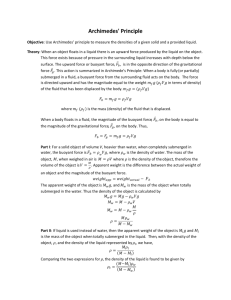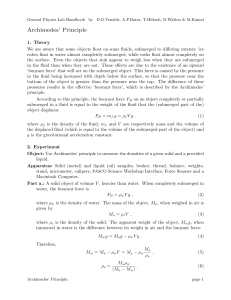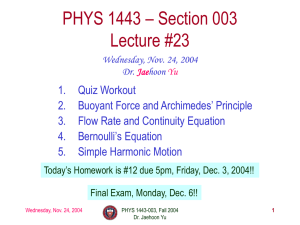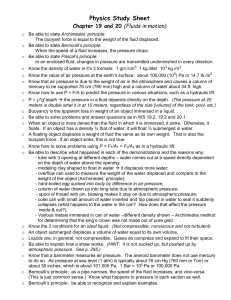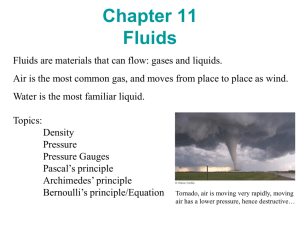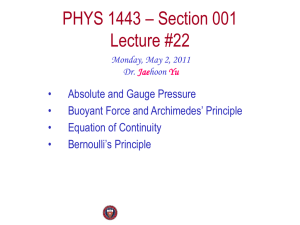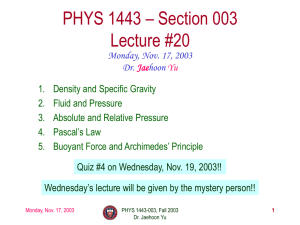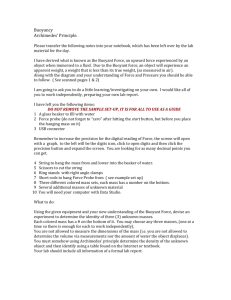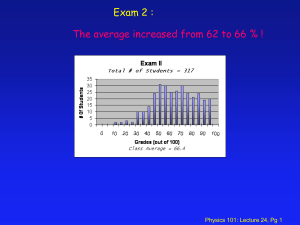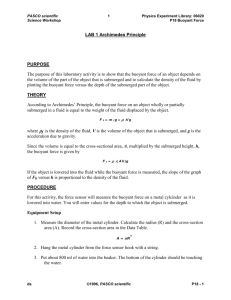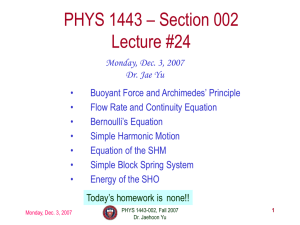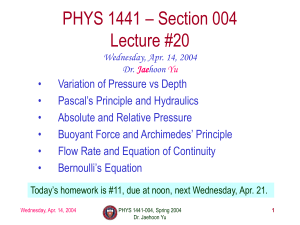phys1443-fall14
advertisement
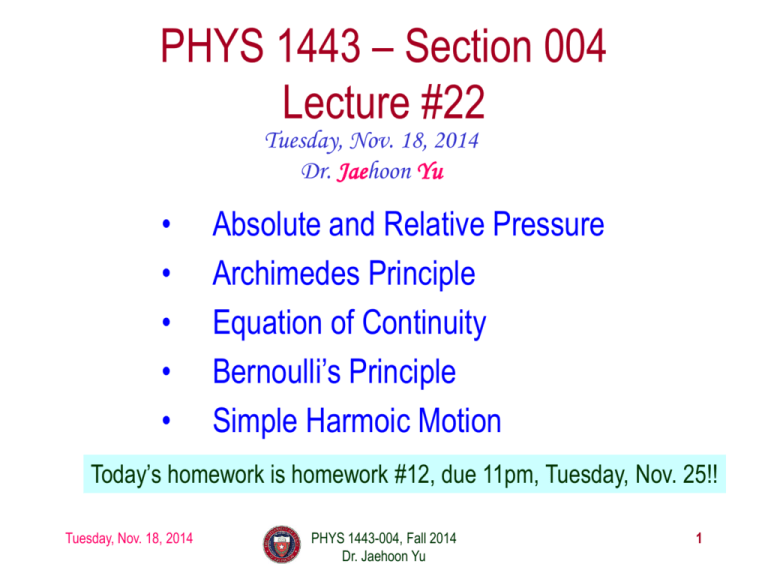
PHYS 1443 – Section 004 Lecture #22 Tuesday, Nov. 18, 2014 Dr. Jaehoon Yu • • • • • Absolute and Relative Pressure Archimedes Principle Equation of Continuity Bernoulli’s Principle Simple Harmoic Motion Today’s homework is homework #12, due 11pm, Tuesday, Nov. 25!! Tuesday, Nov. 18, 2014 PHYS 1443-004, Fall 2014 Dr. Jaehoon Yu 1 Absolute and Relative Pressure How can one measure pressure? P0 P h One can measure the pressure using an open-tube manometer where one end is connected to the system with unknown pressure P and the other open to air with pressure P0. The measured pressure of the system is P = P0 + r gh This is called the absolute pressure, because it is the actual value of the system’s pressure. In many cases we measure the pressure difference with respect to the atmospheric pressure to avoid the effect of the changes in P0 that G depends on the environment. This is called gauge or relative pressure. P P P0 gh The common barometer which consists of a mercury column with one end closed at vacuum and the other open to the atmosphere was invented by Evangelista Torricelli. Since the closed end is at vacuum, it does not exert any force. 1 atm of air pressure pushes mercury up 76cm. So 1 atm is P0 gh (13.595 103 kg / m3 )(9.80665m / s 2 )(0.7600m) 1.013 105 Pa 1atm Tuesday, Nov. 18, PHYS 1443-004, Fallthe 2014 2 If one measures the2014 tire pressure with a gauge at 220kPa actual pressure is 101kPa+220kPa=303kPa. Dr. Jaehoon Yu Finger Holds Water in Straw You insert a straw of length L into a tall glass of your favorite beverage. You place your finger over the top of the straw so that no air can get in or out, and then lift the straw from the liquid. You find that the straw strains the liquid such that the distance from the bottom of your finger to the top of the liquid is h. Does the air in the space between your finger and the top of the liquid in the straw have a pressure P that is (a) greater than, (b) equal to, or (c) less than, the atmospheric pressure PA outside the straw? Less pinA What are the forces in this problem? Gravitational force on the mass of the liquid ( ) Fg mg = r A L - h g Force exerted on the top surface of the liquid by inside air pressure Fin pin A mg p AA Force exerted on the bottom surface of the liquid by the outside air Fout p A A Since it is at equilibrium Fout Fg Fin 0 Cancel A and solve for pin Tuesday, Nov. 18, 2014 pin pA g L h PHYS 1443-004, Fall 2014 Dr. Jaehoon Yu pA A g L h A pin A 0 So pin is less than PA by ρg(L-h). 3 Buoyant Forces and Archimedes’ Principle Why is it so hard to put an inflated beach ball under water while a small piece of steel sinks in the water easily? The water exerts force on an object immersed in the water. This force is called the buoyant force. How large is the The magnitude of the buoyant force always equals the weight of the buoyant force? fluid in the volume displaced by the submerged object. This is called the Archimedes’ principle. What does this mean? Let‘s consider a cube whose height h and cross sectional area A is filled with fluid and in its equilibrium so that its weight Mg is balanced by the buoyant force B. The pressure at the bottom of the cube is larger than the top by gh. h Mg B Tuesday, Nov. 18, 2014 Therefore, P B / A gh B PA ghA Vg B Vg Mg Fg PHYS 1443-004, Fall 2014 Dr. Jaehoon Yu Where Mg is the weight of the fluid in the cube. 4 More Archimedes’ Principle Let’s consider the buoyant force in two special cases. Case 1: Totally submerged object Let’s consider an object of mass M, with density 0, is fully immersed in the fluid with density f . The magnitude of the buoyant force is B = r f Vg The weight of the object is Fg Mg 0Vg h Mg B Therefore total force in the system is What does this tell you? Tuesday, Nov. 18, 2014 F = B - Fg= ( r f - r0 )Vg The total force applies to different directions depending on the difference of the density between the object and the fluid. 1. If the density of the object is smaller than the density of the fluid, the buoyant force will push the object up to the surface. 2. If the density of the object is larger than the fluid’s, the object will sink to the bottom of the fluid. PHYS 1443-004, Fall 2014 Dr. Jaehoon Yu 5 More Archimedes’ Principle Case 2: Floating object h Mg B Let’s consider an object of mass M, with density 0, is in static equilibrium floating on the surface of the fluid with density f , and the volume submerged in the fluid is Vf. The magnitude of the buoyant force is The weight of the object is B = r f Vf g Fg Mg = r0V0 g Therefore total force of the system is F = B - Fg = r f Vf g - r0V0 g 0 Since the system is in static equilibrium r f Vf g = r0V0 g Vf r0 = rf V0 What does this tell you? Tuesday, Nov. 18, 2014 Since the object is floating, its density is smaller than that of the fluid. The ratio of the densities between the fluid and the object determines the submerged volume under the surface. PHYS 1443-004, Fall 2014 Dr. Jaehoon Yu 6 Ex. for Archimedes’ Principle Archimedes was asked to determine the purity of the gold used in the crown. The legend says that he solved this problem by weighing the crown in air and in water. Suppose the scale read 7.84N in air and 6.86N in water. What should he have to tell the king about the purity of the gold in the crown? In the air the tension exerted by the scale on the object is the weight of the crown In the water the tension exerted T water by the scale on the object is Therefore the buoyant force B is Tair = mg 7.84 N mg B 6.86 N B Tair Twater 0.98N Since the buoyant force B is B wVw g wVc g 0.98N The volume of the displaced water by the crown is Vc Vw Therefore the density of the crown is c = 0.98 N 0.98 = = 1.0 ´ 10 -4 m 3 w g 1000 ´ 9.8 7.84 mc mc g 7.84 3 3 = = 8.0 ´ 10 kg / m = = Vc Vc g Vc g 1.0 ´ 10 -4 ´ 9.8 3kg/mFall 3, this Tuesday, Nov. the 18, 2014 1443-004, 2014crown is not made of pure gold. Since density of pure gold isPHYS 19.3x10 Dr. Jaehoon Yu 7 Example for Buoyant Force What fraction of an iceberg is submerged in the sea water? Let’s assume that the total volume of the iceberg is Vi. Then the weight of the iceberg Fgi is Fgi = riVi g Let’s then assume that the volume of the iceberg submerged in the sea water is Vw. The buoyant force B caused by the displaced water becomes B = rwVw g Since the whole system is at its static equilibrium, we obtain Therefore the fraction of the volume of the iceberg submerged under the surface of the sea water is riVi g = rwVw g 3 917kg / m Vw ri = = 0.890 = 3 Vi r w 1030kg / m About 90% of the entire iceberg is submerged in the water!!! Tuesday, Nov. 18, 2014 PHYS 1443-004, Fall 2014 Dr. Jaehoon Yu 8 Flow Rate and the Equation of Continuity Study of fluid in motion: Fluid Dynamics If the fluid is water: Water dynamics?? Hydro-dynamics •Streamline or Laminar flow: Each particle of the fluid Two primary follows a smooth path, a streamline types of flows •Turbulent flow: Erratic, small, whirlpool-like circles called eddy current or eddies which absorbs a lot of energy Flow rate: the mass of fluid that passes the given point per unit time m / t m1 1V1 1 A1l1 1 A1v1 t t t since the total flow must be conserved m1 m2 1 A1v1 2 A2 v2 t t Equation of Continuity Tuesday, Nov. 18, 2014 PHYS 1443-004, Fall 2014 Dr. Jaehoon Yu 9 Ex. for Equation of Continuity How large must a heating duct be if the air moving at 3.0m/s through it can replenish the air in a room of 300m3 volume every 15 minutes? Assume the density of the air remains constant. Using equation of continuity r1 A1v1 = r2 A2 v2 Since the air density is constant A1v1 = A2 v2 Now let’s imagine the room as the large section of the duct A2 l2 / t V2 A2 v2 300 2 0.11 m = = A1 = = 3.0 900 v1 v1 × t v1 Tuesday, Nov. 18, 2014 PHYS 1443-004, Fall 2014 Dr. Jaehoon Yu 10
